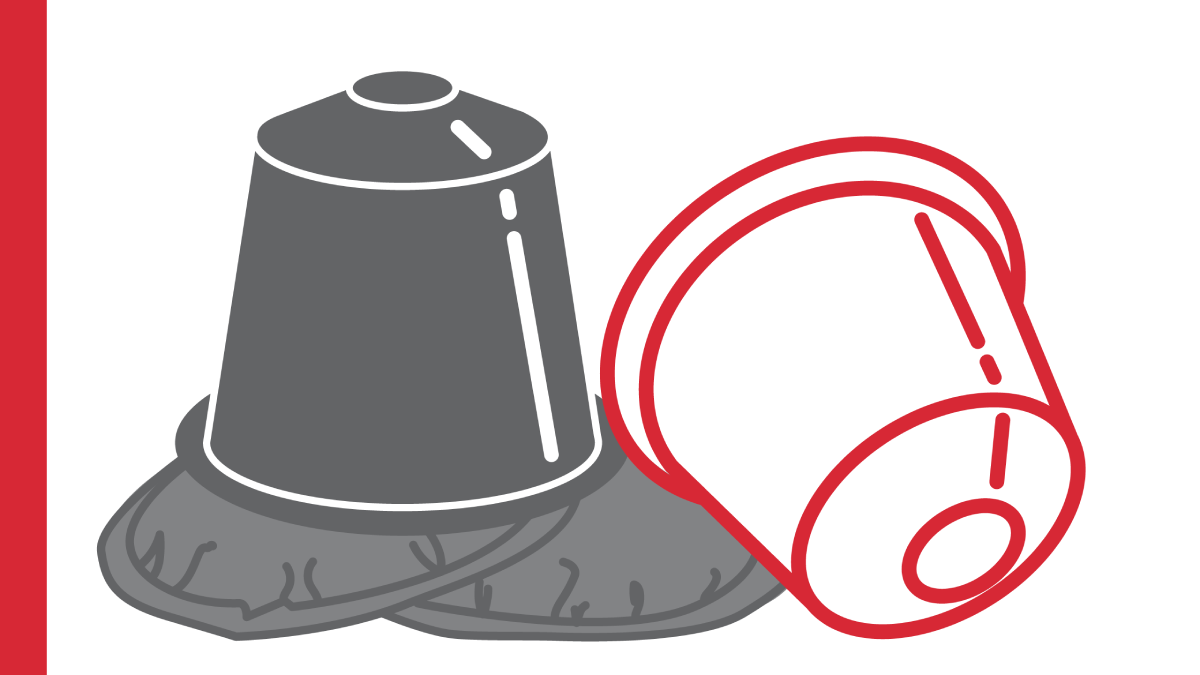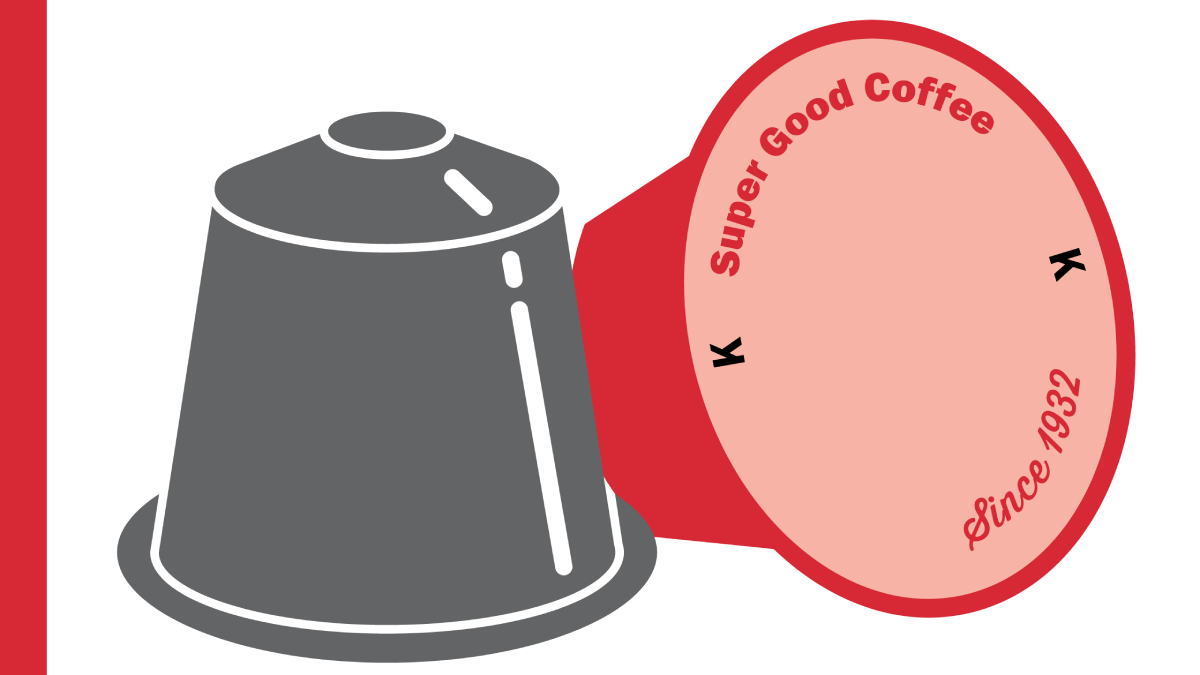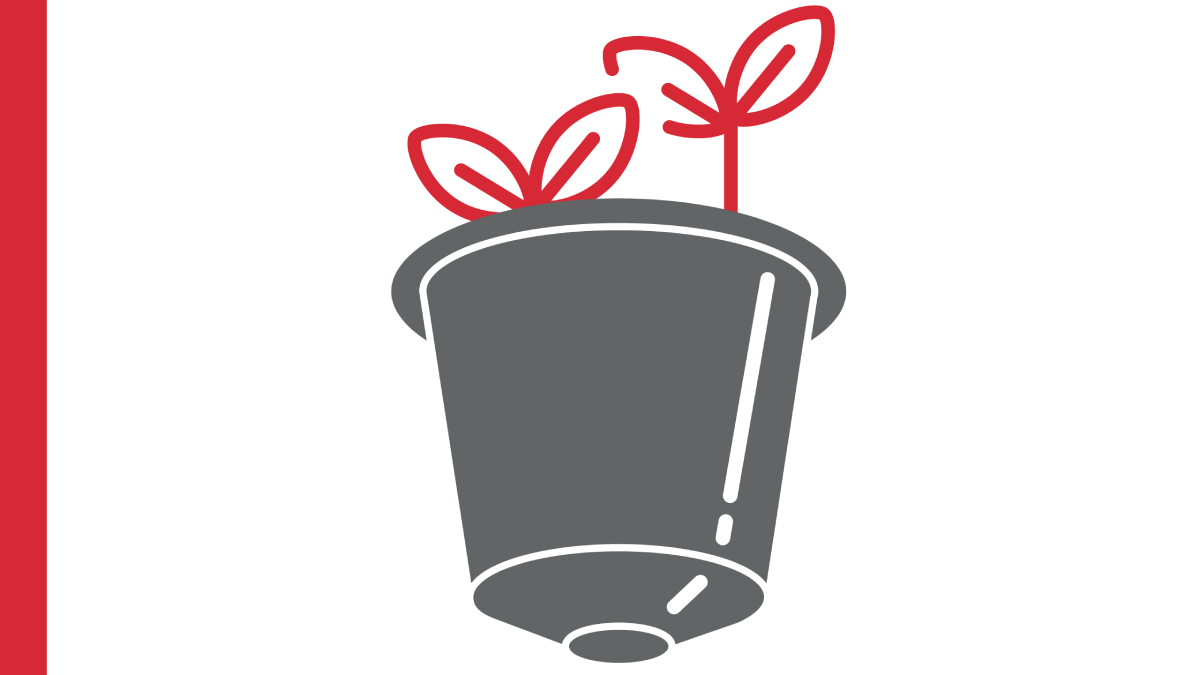Guide to Recycling K-Cups & Coffee Pods

Updated: January 29, 2025
The issue of recycling K-Cup® and coffee pods is often hidden behind a veil of mystery that leads many of us to question what’s really going on.
In 2020 alone, 25% of US adults (1) used coffee capsules (pods and discs) to make their coffee. Coffee pods are a super convenient and delicious way to make your go-juice in the morning, but they result in massive waste.
If this concerns you, then here’s your guide to recycling K-Cup® and coffee pods.
What are K-Cups® & Coffee Pods?

K-Cups® and coffee pods are both used for brewing single cups of coffee, and have become increasingly popular in recent years due to their convenience and ease of use.
Coffee Pods
Coffee pods are single-serve coffee, tea, or hot chocolate, packaged in small plastic cups. The cup has a filter containing the coffee or tea, and there are two needles in the coffee pod machine that puncture both the lid and the bottom of the pod. Hot water then flows through the pod, through the filter, and then exits out of the bottom into your cup.
K-Cups®
The real difference between K-Cups® and coffee pods is the branding. K-Cup is a branded coffee pod manufactured by Keurig®.
Are K-Cups® & Coffee Pods Recyclable?
Keurig® claims (2), “Since the end of 2020, 100% of Keurig®® K-Cup® pods are recyclable. We’ve spent years completing intensive testing, development, and supply chain transition to produce a product that is not only recyclable, but can actually be recycled. We chose polypropylene (#5 plastic) because it is widely accepted for curbside recycling in a majority of communities across North America and there is growing demand for it as a recycled material.”
This is a great step in the right direction, but does this mean that now you can simply toss it in your recycling bin? The answer: check your local recycling service.
Check Your Local Recycling Service
When you see the recycling arrows (Mobius symbol) on K-Cup®, or any item for that matter, it does not mean that it’s accepted at your local Material Recycling Facility (MRF), nor should you treat the chasing arrows symbol as a reliable indicator. Recycling signs and symbols are used by manufacturers to help distinguish the chemical composition of the plastic, not to let consumers know if it can be tossed in recycling bins. That’s under the responsibility of your local recycling service.
K-Cups® & Pods Are Too Small
Even when your local recycling facility accepts #5 plastic, that still doesn’t mean they will accept K-Cup®. The reality is K-Cup® are too small to pass through the screening process in your standard U.S. facility, making them largely unrecoverable.
Keurig’s® EASY-PEEL Technology
Despite the uphill battle for Keurig®, they continue to search for better product sustainability. November 2021 saw the introduction of a new phase of Keurig’s® recyclable K-Cup® pod journey, EASY-PEEL (2) lid technology, on select items. These lids are designed with a built-in tab, making it easy and convenient to peel and dispose of the foil lid. This makes it easier to dispose of the grounds before placing the K-Cup® pod into recycling.
K-Cycle® Recycling & Composting Program
This is one of the premier recycling programs dedicated to keeping K-Cup® out of landfills. Sign up for their service, and they’ll send you a recycling bin for your K-Cup®. Fill up and send it back. Simple.
According to K-Cycle (3), “A simple way to make sure that every K-Cup® pod is fully recycled — giving all materials a second life and reducing waste.”
Check out this helpful list of dos and don’ts of recycling K-Cups.
Recycle A Cup® Cutter
A device called Recycle A Cup® Cutter (4) can break down a typical coffee pod into its components:
1. Plastic
2. Aluminum
3. Coffee Grinds
4. Paper Filter
After separation, the pod or K-Cup® is ready for compost or recycling. But again, can those components be composted or recycled? It’s important to check with your local recycling and composting service for acceptable items to confirm that they will take your components.
Reuse Your K-Cups®

Reusing your K-Cup® is one of the best options for sustainability. There are many ways you can put your K-Cups® to good use after your coffee is brewed. Here are some creative suggestions you can use that we recommend!
Seed Starters
Use your K-cups to make tiny seed starters (5):
1. Empty and rinse the K-Cups®.
2. Fill with potting soil.
3. Mixing with coffee grounds is optional.
4. Push the seeds into the cups.
5. Cover with a small plastic bag.
Cover the seeds with a mixture of potting soil and coffee grounds, and then set the cups somewhere that allow them to drain. The next step is to light mist the cups and cover them with plastic wrap to create a greenhouse effect. Place your K-Cups® in a sunny window and check on them periodically to make sure they’re moist. Once the seedlings start outgrowing the cups, they’re ready for transfer.
Hanging Planters
You can repurpose your used K-Cups® by making small DIY hanging planters (6) from them. These are especially great for small spaces and can be used as a learning project for kids. Hanging planters brighten your space and give it a beautiful natural aesthetic. They can also be used as centerpieces to bring cheer and liveliness to the room.
Halloween Decoration Lights
Keep your Halloween recycling spirit alive using your Keurig® K-Cups® to make ghoulish lights (7). You can draw faces on them using a sharpie or buy stickers. During the day, they look like white ghosts, but they light up and glow like little pumpkins at night. This is a fun, creative way to repurpose your K-Cups®.
Need lights for your ghoulish K-Cup®? This craft offers an excellent opportunity to recycle your old Christmas lights.
Greener Coffee-Making Options
If you’re willing, you can entirely ditch your single-serve coffee options and make the whole process a little greener. We aren’t suggesting immediately changing your habits, but an occasional change in routine from time to time can really add up. Here is a list of options:
- Compostable Coffee Pods
- Reusable Coffee Pods
- Reusable K-Cups
- Pour-over Method
- French Press
- Percolator
Compostable Coffee Pods
You can use coffee pods made from organic and biodegradable materials. Unfortunately, you cannot compost these coffee pods in your compost bin in the backyard, as they require commercial composting.
Do not put the compostable coffee pods in your commercial compost bin before confirming this service with your local provider. Some materials can disrupt the composting process.
Reusable Pods
You can switch your single-serve coffee pods to reusable pods, made mainly from aluminum. There are many models of reusable pods available under different brands. The only minor inconvenience is cleaning out the pod, but that extra minute or two is what keeps it out of the environment.
Reusable K-Cups®
Did you know they make reusable K-Cup®? Purchase your own coffee grinds and add it to the K-Cup®. Brew, clean, refill, and repeat.
Pour-Over Method
While Keurigs® are popular because of their convenience, the methodology is nothing new. Take the process into your own hands and manually pour the hot water over the coffee grinds. Take it a step further and use either a compostable or reusable coffee filter - and that’s about as minimalist as you can get as a coffee drinker.
French Press
The beauty of the French Press is its simplicity. Made of metal, glass, and wooden components, what you buy is what you get. This method uses a built-in durable filter that can last a lifetime with good quality and care. The only thing you’ll need to buy afterward are the grinds!
Tip
Use coarsely grind beans. That way, the filter will catch all the grinds when it’s time to press.
Percolators
Percolators aren’t a thing of the past. Though you won’t walk into a modern coffee shop and ask for percolated coffee, these contraptions offer one of the most sustainable coffee-making solutions. A quality stainless steel percolator will last you a lifetime with proper care. All that’s needed to complete the contraption? Coffee grinds and hot water.
Final Thoughts
If you’re passionate about environmental conservation and more sustainable processes, you can start with your coffee in the morning. Whether you decide to repurpose or recycle your K-Cups® and coffee pods, you can sleep better knowing you’re playing your part to keep plastic away from landfills.
Reference List
1. M. Ridder, (2022, January 13). Coffee capsule usage among past day coffee drinkers U.S. 2020. Statista. https://www.statista.com/statistics/935472/coffee-capsule-usage-among-us-past-day-coffee-drinkers/
2. Keurig Recycling - Recyclable K-Cup Pods & Recycling Information. Keurig. https://www.keurig.com/recyclable
3. Keurig Commercial K-Cycle. K-Cycle. https://keurigkcycle.com/
4. Recycle or Repurpose Your Coffee Pods. Recycle A Cup. https://www.recycleacup.com/
5. Steele, L. (2021, July 12). Start seeds in recycled K-cups + use coffee grounds in the garden. Fresh Eggs Daily®. https://www.fresheggsdaily.blog/2014/02/k-cup-recycling-toss-grounds-in-your.html
6. Taylor. (2013, January 11). DIY: Hanging K-Cup Planters. Iowa Natural Heritage Foundation. https://www.inhf.org/blog/blog/diy-hanging-k-cup-planters/
7. The Kim Six Fix. K-Cup Recycled Garland (Ghosts By Day, Pumpkins By Night). The Kim Six Fix. https://www.thekimsixfix.com/2014/10/k-cup-recycled-garland-ghosts-by-day.html
